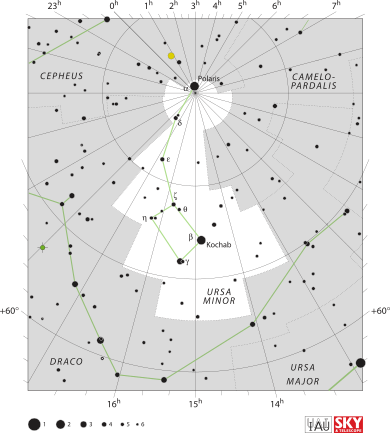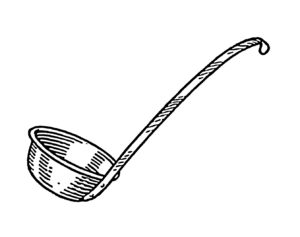Ursa Minor facts for kids
| Constellation | |

List of stars in Ursa Minor
|
|
| Abbreviation | UMi |
|---|---|
| Genitive | Ursae Minoris |
| Pronunciation | genitive |
| Symbolism | The Little Bear |
| Right ascension | 15 |
| Declination | +75 |
| Quadrant | NQ3 |
| Area | 256 sq. deg. (56th) |
| Main stars | 7 |
| Bayer/Flamsteed stars |
23 |
| Stars with planets | 1 |
| Stars brighter than 3.00m | 3 |
| Stars within 10.00 pc (32.62 ly) | 0 |
| Brightest star | Polaris (1.97m) |
| Messier objects | 0 |
| Meteor showers | Ursids |
| Bordering constellations |
Draco Camelopardalis Cepheus |
| Visible at latitudes between +90° and −10°. Best visible at 21:00 (9 p.m.) during the month of June. |
|
Ursa Minor is a constellation you can see in the northern sky. People often call it the Little Bear or the Little Dipper. It looks like a small ladle or scoop. Its "handle" points to Polaris, which is also known as the North Star.
This constellation is similar to Ursa Major, which is called the Big Bear or Big Dipper. Both have a shape that looks like a dipper. The ancient astronomer Ptolemy first listed Ursa Minor. Today, it is one of the 88 modern constellations. Ursa Minor is special because it contains the north celestial pole. This means it's directly above Earth's North Pole. However, this will slowly change over hundreds of years. This slow wobble of Earth's axis is called precession.
Contents
What Makes Ursa Minor Special?
The Stars of the Little Dipper
Ursa Minor is known as the Little Dipper because its seven brightest stars form a dipper shape. The brightest star, Polaris, is at the end of the dipper's handle. It is often called the North Star.
Polaris is a bright, yellow-white supergiant star. Its brightness can change, which makes it a special type of star called a Cepheid variable. The second brightest star in Ursa Minor is Kochab. It is a large orange star.
The four stars that make up the "bowl" of the Little Dipper are very helpful for stargazers. They have different brightness levels. These stars can help you learn how bright stars need to be to see them. This is useful if you live in a city where lights make dimmer stars hard to spot. It can also be a fun way to test your eyesight!
Deep Sky Objects
In the area of Ursa Minor, there is a small dwarf galaxy. It is known as the Ursa Minor Dwarf.
History and Stories
Many drawings show Ursa Minor as a baby bear with a very long tail. Some old stories say its tail is long because it was swung around the North Pole!
In ancient Greek stories, Ursa Minor and Ursa Major are linked to the myth of Callisto and Arcas. But in older versions, Ursa Minor was seen as a dog, not a bear. This might explain its long tail and an older name for Polaris. The North Star used to be called Cynosura, which means "the dog's tail."
Another old Greek myth says the seven stars of the Little Dipper were seven sisters. They were the daughters of Atlas, called the Hesperides. Their story was connected to other nearby constellations like Boötes, Ursa Major, and Draco.
Related Topics
- Ursa Major
- Ursa Minor Beta, a place in a famous science fiction story called The Hitchhiker's Guide to the Galaxy.
Images for kids
See also
 In Spanish: Osa Menor para niños
In Spanish: Osa Menor para niños





